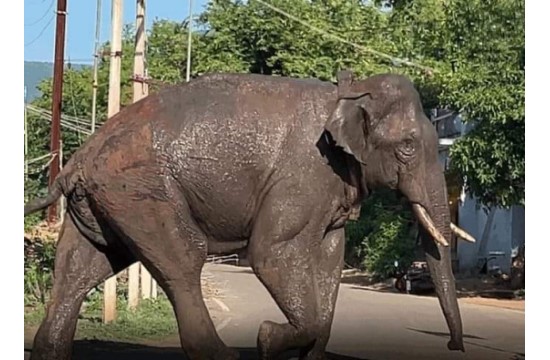In the man-elephant conflict, the maximum we can do is shift the problem from one place to another, says UN environmentalist
 By Rejimon Kuttappan
By Rejimon Kuttappan
Deputy Editor
THIRUVANANTHAPURAM: There are no lasting solutions to the man-elephant conflict, a United Nations environmentalist said while dissecting the conflict between humans and rogue elephants in the Western Ghats.
“We can just shift the problem from one place to another,” Faizi S, an ecologist and United Nations environmental negotiator based out of Kerala, said.
Many villages in and around Munnar, a quaint town in the Western Ghats, have been affected by the ruckus of three rogue elephants named Ari Komban (Rice Tusker), Chakka Komban (Jackfruit Tusker), and Motta Valan (Furless Tailed Tusker).
Out of the three elephants, when raids by Ari Komban for rice became permanent trouble for villagers, Kerala Forest officials camped for weeks, spent nearly Rs80 lakhs, darted him, collared him, and transported him some 80km away from Chinnakanal to Periyar Tiger Reserve, on April 29 this year.

After a lengthy legal dispute in the Kerala High Court between groups in favour of and against capturing Ari Komban, he was moved to a new location.
Creating chaos
Interestingly, as Faizi said, Ari Komban moved out from Periyar Tiger Reserve, entered Kambam town in Tamil Nadu, and created chaos on Saturday.
[Also by the same author: A traveller who relishes ‘risky routes’ and the plethora of challenges that comes with it – THE NEWS PORTER]
Understanding the gravity of the situation, the Tamil Nadu Government deployed their forest officials with an order to dart the elephant, and the Tamil Nadu Forest Minister M Mathiventhan himself came down to Kambam to coordinate the operations.
However, by yesterday (May 28) evening, Ari Komban had again moved into the forest.
Radio collar signals
Meanwhile, an officer in the Kerala Forest department told The News Porter that based on signals from the radio collar, the elephant is again heading to Kambam town.
Elephants, Faizi pointed out, are adaptive animals. “Whatever blocks we set up, they will adapt,” he added.
Dr Faizi explained that various methods have been considered to prevent elephants from entering the village, such as digging a trench or putting up solar fences. However, these methods have proven to be ineffective as the elephants can level the trench or break the fences.
An alternative
Another option was to tie ropes with beehives to deter the elephants, but this could attract bears who will come for the honey. Additionally, it is difficult to predict the direction a panicked tusker will run in.
Dr Faizi added that putting up street lights and officials forming WhatsApp groups to monitor the elephants’ movement would help.
Interestingly, he said, elephants attack people living in the fringe areas of forests who go for open defecation.
“If we build toilets for people living on the fringe of forests, some 20 per cent of such attacks can be reduced,” he said.
As per the information provided by the Union Ministry of Environment, Forest and Climate Change in March during a Lok Sabha session, Kerala is home to 5,706 elephants, out of the total 29,964 elephants in India. Only Assam has a higher population of elephants among the states.
The data also reveals that from 2019 to 2022, elephants in Kerala caused the deaths of 57 people.
Don’t blame the animal
According to Joseph Kurian, a farmer in Idukki and a green activist, “It is we humans who have encroached on their habitat”.
“So, we can’t blame these animals. We not only encroached on their area but also spoiled their natural habitat. So, they venture into our area looking for food,” Joseph noted.
Three villagers were killed in the Guar attack in Kerala last week.
Data from the Forest Department on human-wildlife conflicts in the past three years indicate that gaurs accounted for only one death during 2017-18 while three persons each were injured in 2017-18 and 2018-19.
However, instances of crop loss and property damage caused by animals show an increasing trend in the past two years. While 58 such cases were reported during 2020-2021, it went up to 75 in 2021-2022. Three deaths and three cases of injury were also reported last year.
(Main/Featured picture of Ari Komabn in Munnar Town has been sourced from the Internet)












More Stories
Every Keralite’s pride: How Kerala is celebrating Sanju Samson’s selection in World Cup squad
When Rajesh Khanna left the shoot mid-way, told scribe, ‘I’m going for a screw’
Of the Northern Lights and an Adventure with Huskies in Swedish Lapland!